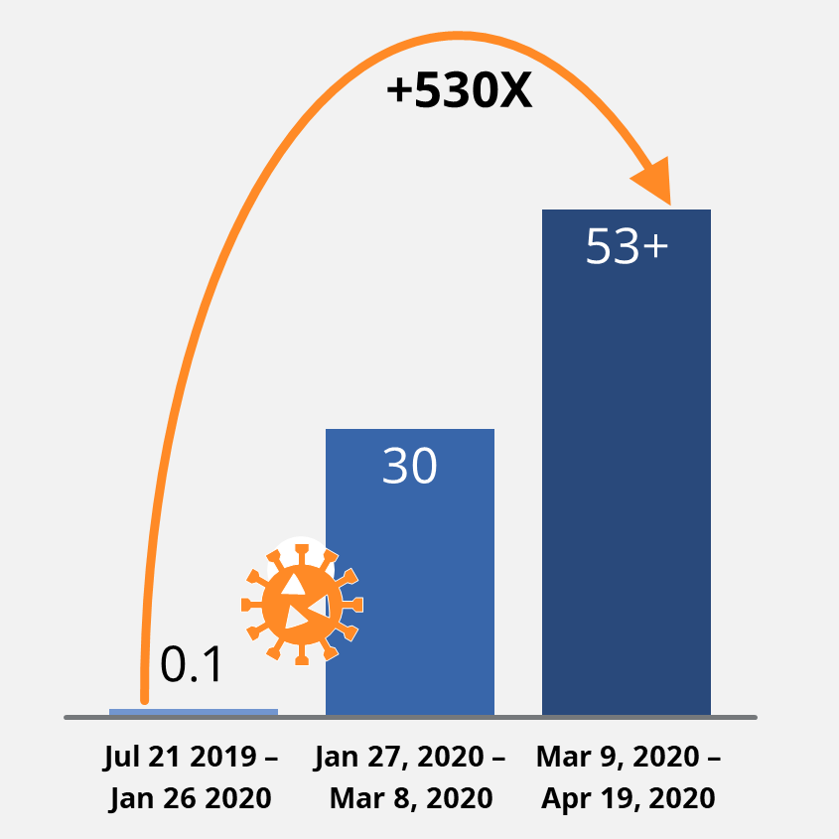Co-authored by Keith Blackwell, Chief Operating Officer, Aberdeen
How should employers monitor the productivity of its employees working from home?

Buyer Intent Score for Remote Employee Surveillance category dramatically increased from 0.1 to 53+ over six weeks since the beginning of COVID-19 social distancing as companies adjust to the abrupt shift to remote work force. Source: ISG Buyer Intent Research using Aberdeen intent scores, 2020
According to ISG Research about the intentions of IT buyers, organizations feel they need help monitoring and measuring employee productivity now more than ever. When we looked at more than 2,000 large enterprises impacted by the transition to remote work, we saw that, in just the last eight weeks, these organizations demonstrated more than a 500-times increase in their interest in remote employee surveillance solutions. This is the most dramatic increase of interest in any solution category we have ever observed – all correlated to the start of the COVID-19 pandemic.
Our findings reveal a tell-tale digital footprint of a fast-paced buyers’ journey in the remote employee surveillance category. Our research approach provides an intent score, ranging from 0 to 100, indicating where each buyer is in its buying journey. By aggregating intent scores across accounts, we identified an extraordinary trend in interest for remote employee surveillance in the total addressable market – from basically zero to a score of nearly 60 in late March.
The pandemic has enterprises scrambling to manage a nearly overnight transition of remote work. Leaders and managers need to make sure that remote workers are productive and meeting their work obligations even with the challenges of childcare, home schooling, elderly care and the list goes on. Given the enormity of this task, our data indicates that many enterprises seem to be leaning toward surveillance over support, potentially overlooking the organizational change management principles, policies and related technologies needed for success.
When employees are in the office, managers can more easily monitor their work hours, interactions, and attitudes along with the usual key performance indicators of employee performance and productivity. But, when employees and managers are working remotely in often-difficult situations, this becomes challenging.
Remote employee surveillance technology monitors a host of metrics, such as:
- the number of phone calls an employee makes
- the total time they actively interact with their computer user interface
- the percentage of time they spend browsing consumer websites
- the percentage of time their conferencing software is top-of-screen during scheduled meetings (as opposed to running in the background behind Clash of Clans!)
No doubt, most of the companies we looked at had at least some remote employees before the pandemic. These workers were likely selected based on their responsibilities, geographic requirements, specific temperament for isolated work, self-motivation and other important indicators of remote employee success. Now that nearly everyone has become a remote worker, we face the challenge of supporting teams with a vast array of technical ability, maturity, self-motivation, home-based technical infrastructure and home-life circumstances. Meanwhile, workers are under tremendous stress because their work circumstances are imperfect and their employment may be at risk as the pandemic drags on.
Building Trust in a Work-from-home World
Under these conditions, wholesale adoption of employee work-from-home surveillance software can create unanticipated problems. First, a key policy decision must be made: how much about the surveillance solution will you reveal to employees? As we know, well-marked traffic cameras certainly slow speeds within their range, but, once outside of that range, most drivers invariably increase speed. Similarly, employees may adapt or find ways of countering employee surveillance technology if they believe their privacy is being invaded.
The alternative is to deploy surveillance software clandestinely, which raises a set of policy and legal issues that vary by country. More importantly, the use of surreptitious surveillance may break hard-won trust with your employees in ways that can impact productivity and retention at a time when you need stability and continuity more than ever. Enterprises need not risk appearing insensitive to the complicated problems newly remote employees are dealing with at this time.
Instead of surveilling their employees, leaders must support and empower them. Assessing and boosting employee productivity at this time requires real leadership and a robust organizational change management strategy that aligns the needs of employees with their leaders and organizational objectives. Today’s workforce needs a program built on training, trusting and verifying. The question might be, “Shouldn’t leaders have been creating an empowered workforce all along?”
Now is the time to make the investment in adapting, adopting and optimizing workforce practices and growing a sense of engagement and community that is deliberate and enduring. We have the time to do this right as the remote workforce trend isn’t going away any time soon. Assuring remote employee productivity should be a plan for the long haul, and it must be comprehensive to include employee health, safety and productivity. Otherwise, recovering from rushed decisions focused on monitoring and measuring your employees will be a long-haul endeavor with minimal benefit for you and your employees.
ISG can help with both your organizational change approach and policy development to empower and enhance your new future workforce. Contact us to find out how we can help.
